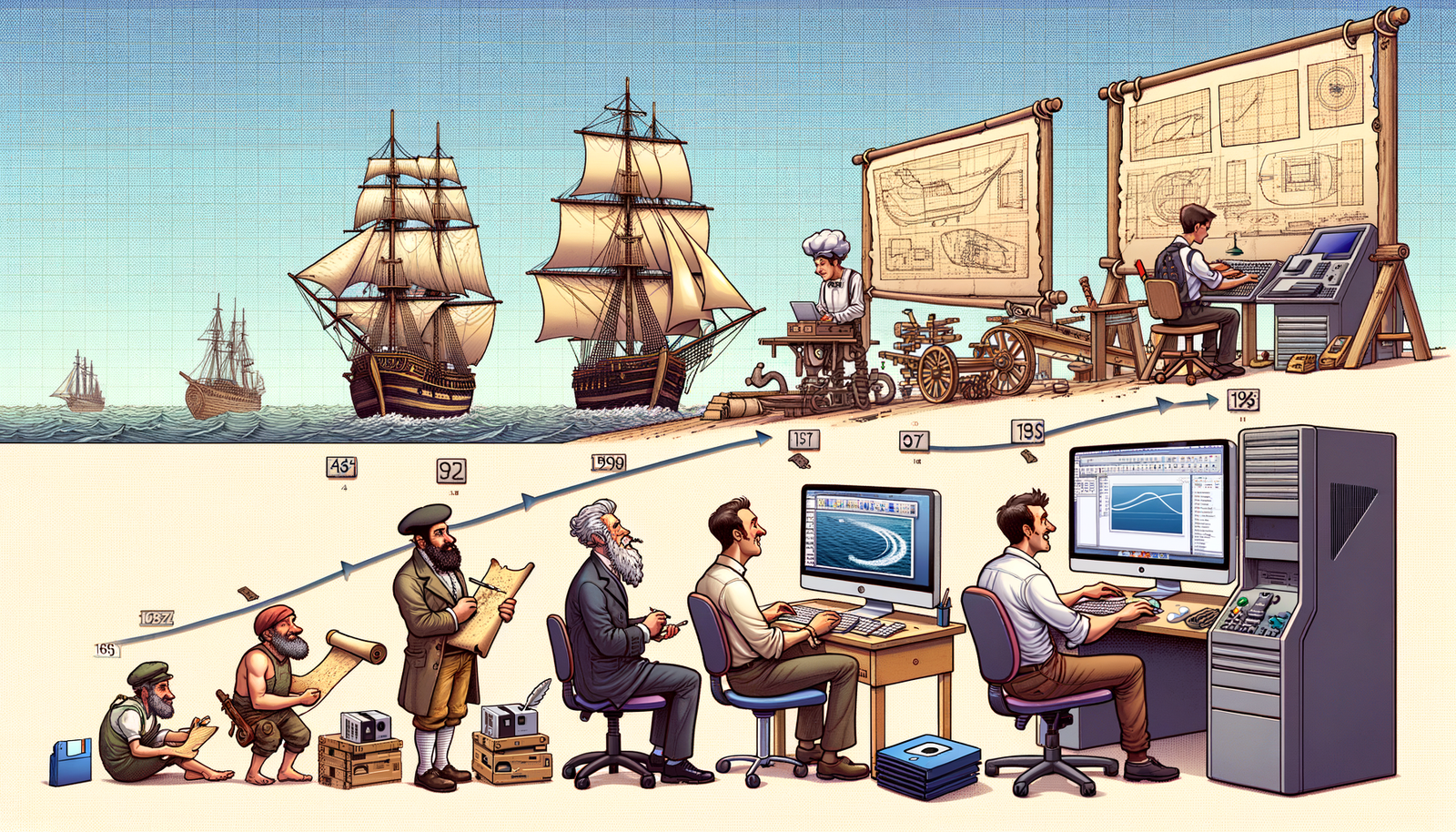Your Cart is Empty
Customer Testimonials
-
"Great customer service. The folks at Novedge were super helpful in navigating a somewhat complicated order including software upgrades and serial numbers in various stages of inactivity. They were friendly and helpful throughout the process.."
Ruben Ruckmark
"Quick & very helpful. We have been using Novedge for years and are very happy with their quick service when we need to make a purchase and excellent support resolving any issues."
Will Woodson
"Scott is the best. He reminds me about subscriptions dates, guides me in the correct direction for updates. He always responds promptly to me. He is literally the reason I continue to work with Novedge and will do so in the future."
Edward Mchugh
"Calvin Lok is “the man”. After my purchase of Sketchup 2021, he called me and provided step-by-step instructions to ease me through difficulties I was having with the setup of my new software."
Mike Borzage
Design Software History: Evolution of Ocean Engineering Software: Transforming Marine Design Through Advanced Simulation and Innovation
November 17, 2024 6 min read


Introduction to Ocean Engineering Software
Ocean engineering software has fundamentally transformed marine design by providing advanced tools that enable engineers to tackle the complexities of the marine environment with precision and efficiency. These specialized software applications are essential in the design and analysis of ships, offshore structures, renewable energy installations, and underwater technology. By simulating real-world conditions, they allow for the optimization of designs, ensuring safety, performance, and compliance with stringent maritime regulations. The importance of ocean engineering software lies in its ability to model and predict the behavior of marine structures under various environmental stresses, which is critical for the success of projects in the challenging oceanic context.
The key applications of ocean engineering software encompass a wide range of marine industries:
- Shipbuilding: Software tools assist in hull design, stability analysis, and propulsion systems, enabling the creation of efficient and safe vessels.
- Offshore Structures: Platforms for oil and gas extraction, as well as wind turbines, rely on software for structural integrity assessments and environmental impact evaluations.
- Renewable Energy: The development of wave and tidal energy converters utilizes simulation software to optimize energy capture and structural resilience.
- Underwater Technology: Submersibles and remotely operated vehicles (ROVs) are designed using software that models hydrodynamic performance and control systems.
The historical context of marine design reveals a transition from traditional methods to sophisticated computational approaches. In the early days, naval architects like William Froude in the 19th century conducted physical model tests to understand ship hydrodynamics. The advent of computers in the mid-20th century introduced new possibilities. In the 1960s, companies like Autokon in Norway developed some of the first computer-aided design (CAD) systems tailored for shipbuilding. The 1970s saw the emergence of software like NAPA, founded by the Finnish company Napa Ltd., which became a leading solution for ship design and operation. These early innovations laid the foundation for today's advanced ocean engineering software, integrating complex simulations and data analysis into the marine design process.
Key Technologies and Methodologies in Ocean Engineering Software
At the core of ocean engineering software are technologies like Finite Element Analysis (FEA) and Computational Fluid Dynamics (CFD), which simulate the physical behaviors of marine structures and the fluids surrounding them. FEA divides a complex structure into smaller, manageable elements, allowing engineers to perform detailed stress and strain analyses under various loads. This methodology is crucial for assessing the structural integrity of ships and offshore platforms. CFD, meanwhile, models the flow of water and air around marine structures, providing insights into hydrodynamic performance, resistance, and propulsion efficiency. By solving the governing equations of fluid flow, CFD helps predict how vessels will behave in different sea conditions.
Notable software examples that employ these technologies include ANSYS and MathWorks. ANSYS provides comprehensive simulation capabilities, combining FEA and CFD to offer a multiphysics approach essential for marine applications. Engineers use ANSYS to model complex interactions between structural components and fluid environments, such as wave loading on offshore structures. MathWorks' MATLAB and Simulink platforms are instrumental in developing custom simulations and control systems for marine vehicles. MATLAB's computational environment allows for advanced data analysis and algorithm development, which are critical in designing autonomous underwater vehicles (AUVs) and control systems for ships.
The integration of hydrodynamics and structural analysis is essential for accurate marine design. Tools like SIMERICS MP and DyTRAN facilitate this integration by allowing simultaneous simulation of fluid-structure interactions. This capability is vital for resilience assessment and performance predictions, ensuring that designs can withstand harsh ocean conditions. For instance, the ability to simulate how a ship's hull responds to wave impacts informs decisions on material selection and structural reinforcement. Moreover, these integrated tools aid in optimizing designs for efficiency, reducing fuel consumption, and minimizing environmental impact.
Pioneering Companies and Influential Figures in the Development of Ocean Engineering Software
The development of ocean engineering software has been driven by pioneering companies and influential figures dedicated to advancing marine technology. Autodesk, known for its AutoCAD software, has extended its reach into marine design by offering tools that facilitate 3D modeling and simulation of marine structures. Their software supports collaborative design processes, enabling teams to work seamlessly on complex projects. Bentley Systems is another leader, providing solutions like MOSES and MAXSURF that specialize in offshore and naval architecture. MOSES is renowned for its capabilities in offshore structure simulation, while MAXSURF caters to ship design and analysis, offering a suite of integrated tools for hull modeling, stability, and motions prediction.
The collaborations between academia and industry have significantly propelled software advancements. Universities such as the Massachusetts Institute of Technology (MIT) and the Norwegian University of Science and Technology (NTNU) have partnered with industry players to develop cutting-edge software tools. These partnerships have led to innovations in simulation methodologies and the incorporation of artificial intelligence in marine design. Influential figures like Dr. Odd M. Faltinsen from NTNU have contributed extensively to the understanding of hydrodynamics in marine structures, influencing the development of simulation software that accurately models these complex phenomena.
Key individuals who have shaped the landscape of ocean engineering technology include Dr. Nick Newman, renowned for his work in marine hydrodynamics, and Dr. J. Randolph Paulling, who made significant contributions to ship stability analysis. Their research has been integral to the algorithms and computational methods used in modern ocean engineering software. Additionally, entrepreneurs like Leonard M. Greene, founder of Safe Flight Instrument Corporation, have introduced innovative technologies that improved the safety and functionality of marine navigation systems, influencing the software that supports these technologies.
Future Trends and Challenges in Ocean Engineering Software
The future of ocean engineering software is being shaped by emerging technologies such as Artificial Intelligence (AI), Machine Learning (ML), and Big Data analytics. These technologies are set to revolutionize marine design practices by enabling predictive modeling and real-time decision-making. AI and ML algorithms can analyze vast amounts of data from simulations and real-world operations to optimize designs and identify potential issues before they arise. For instance, AI-driven software can predict material fatigue in offshore structures, allowing for proactive maintenance and increased safety. Big Data analytics facilitate the processing of extensive datasets collected from sensors on marine vessels and structures, providing insights into performance and operational efficiency.
However, the integration of these advanced technologies presents challenges regarding data integration and real-time simulations. Managing and synchronizing data from multiple sources requires robust software architectures and standardization across platforms. Real-time simulations demand high computational power and efficient algorithms to process data instantaneously, which can be resource-intensive. Moreover, ensuring cybersecurity in the handling of sensitive data is a growing concern, necessitating the development of secure software solutions that protect against potential threats.
The importance of sustainability and eco-friendly design methodologies is increasingly influencing future software developments. Ocean engineering software is evolving to incorporate environmental impact assessments, carbon footprint analysis, and the optimization of designs for minimal ecological disruption. Companies are focusing on creating tools that aid in the development of renewable energy installations, such as offshore wind farms and tidal energy converters, contributing to the global shift towards sustainable energy sources. Software like DNV GL's Sesam provides modules for environmental load analysis, supporting engineers in designing structures that harmonize with marine ecosystems.
Conclusion
Advancements in ocean engineering software have been pivotal in enhancing the capabilities of marine design, enabling engineers to tackle complex challenges with greater confidence and precision. The integration of sophisticated simulation technologies like FEA and CFD, alongside the contributions of pioneering companies and individuals, has led to significant improvements in safety, efficiency, and environmental sustainability. As the landscape of ocean engineering continues to evolve, the incorporation of AI, ML, and Big Data promises to further revolutionize the field.
The journey of ocean engineering software reflects a commitment to innovation and collaboration among industry stakeholders, academia, and technology developers. This collaborative spirit is essential in addressing the future challenges posed by data integration, real-time simulations, and the imperative of sustainable design practices. By fostering partnerships and investing in research and development, the industry can continue to drive forward, embracing new technologies that meet the demands of an ever-changing marine environment.
It is a call to action for all involved in the marine industry to prioritize sustainability and innovation. Through the continued development of advanced software solutions and a commitment to eco-friendly methodologies, the ocean engineering community can contribute significantly to overcoming future marine challenges. Embracing these advancements not only enhances the potential for economic growth but also ensures the protection and preservation of our vital oceanic resources for generations to come.
Also in Design News

Cinema 4D Tip: Maximizing Efficiency in Cinema 4D with XPresso: Essential Tips for Node-Based Workflow
October 26, 2025 3 min read
Read More
Bluebeam Tip: Optimize Collaborative Workflows with Bluebeam Revu's PDF Studio Manager
October 26, 2025 2 min read
Read More
Revit Tip: Optimizing Project Browser Organization in Revit for Enhanced Workflow and Management
October 26, 2025 2 min read
Read MoreSubscribe
Sign up to get the latest on sales, new releases and more …


